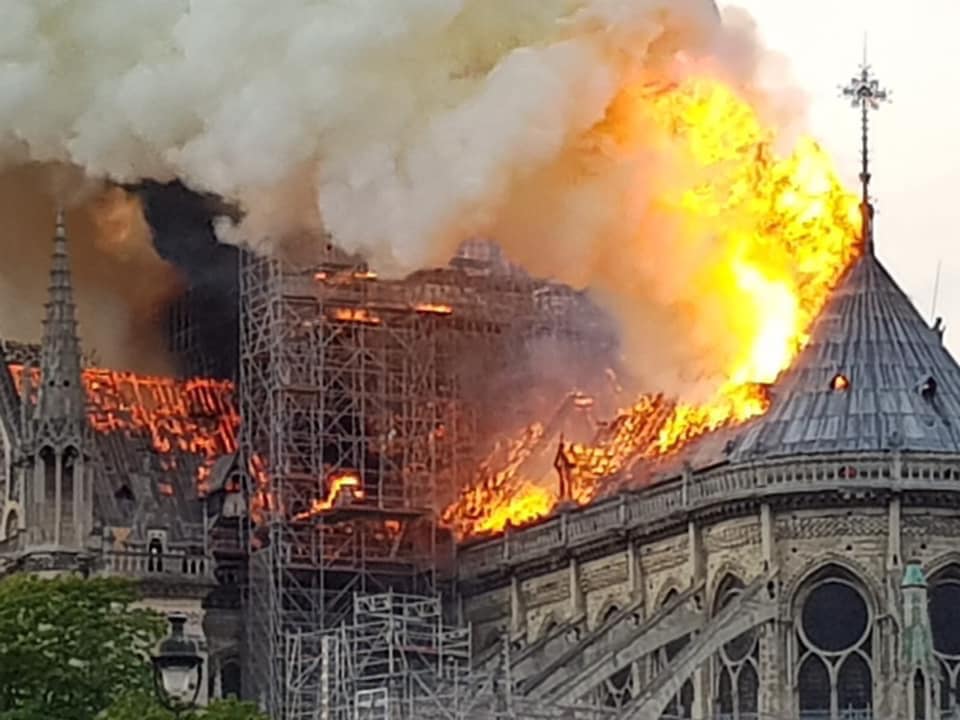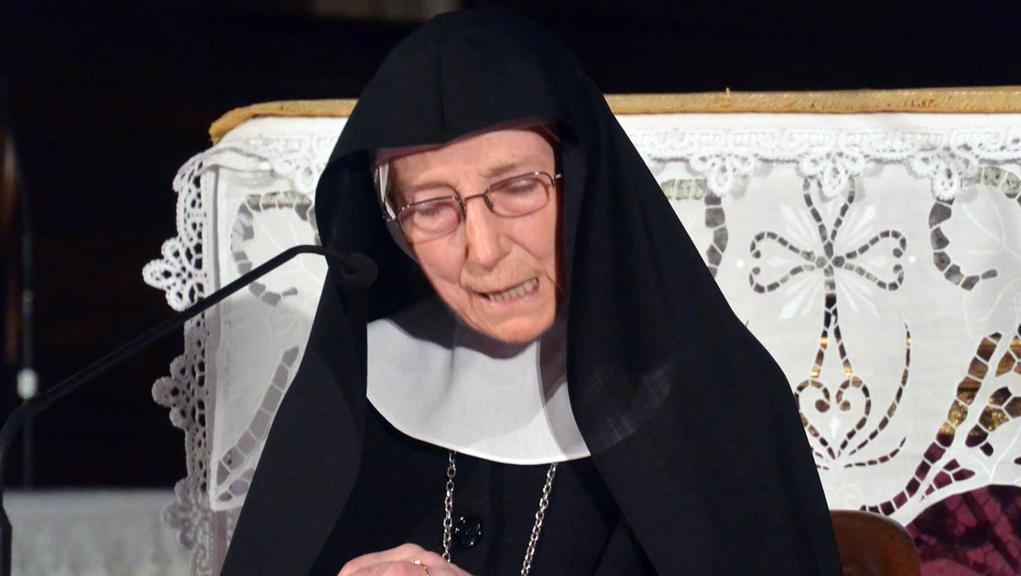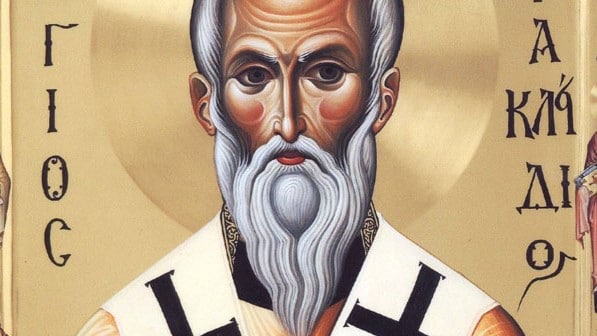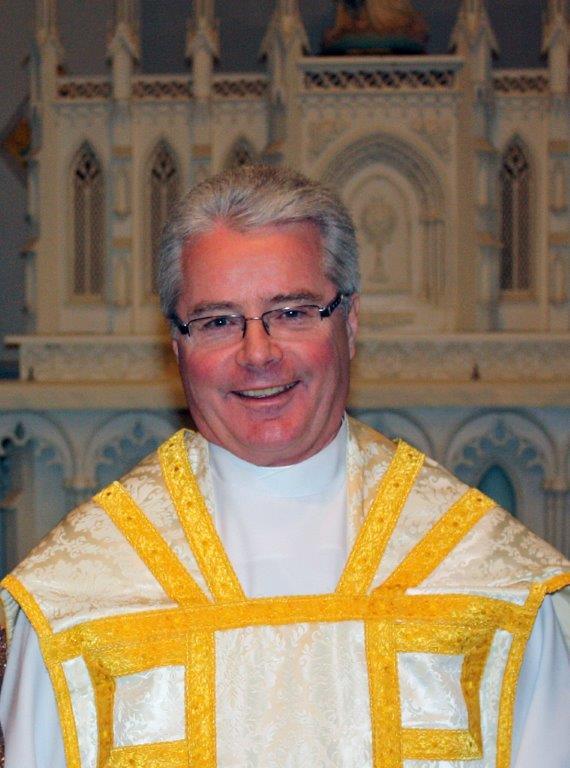Notre Dame of France
Our Lady of Paris 2019




 On Christmas Day in 1886 Paul Claudel attended High Mass at the cathedral of Notre Dame in Paris. He was not particularly moved by the ceremony, which probably was presided over by the newly appointed archbishop. Claudel left and then returned for vespers. “It was the gloomiest winter day and the darkest rainy afternoon over Paris,” he wrote. He listened to the psalms and the Magnificat.
On Christmas Day in 1886 Paul Claudel attended High Mass at the cathedral of Notre Dame in Paris. He was not particularly moved by the ceremony, which probably was presided over by the newly appointed archbishop. Claudel left and then returned for vespers. “It was the gloomiest winter day and the darkest rainy afternoon over Paris,” he wrote. He listened to the psalms and the Magnificat.
For the rest of his life he recalled that he “stood near the second pillar at the entrance to the chancel, to the right, on the side of the sacristy.” There one finds a fourteenth-century statue of the Virgin and Child. “Then occurred the event which dominates my entire life,” he wrote.
“In an instant, my heart was touched and I believed. I believed with such a strength of adherence, with such an uplifting of my entire being, with such powerful conviction, with such a certainty leaving no room for any kind of doubt, that since then all the books, all the arguments, all the incidents and accidents of a busy life have been unable to shake my faith, nor indeed to affect it in any way.”
UPDATE:
THE VAULT HELD!!! the fire stayed ABOVE it!! Only a small part of the vault collapsed. The interior seems to be relatively untouched.
Apparently the great rose window is intact, though the two smaller ones (the north and south windows) are probably gone.
French reporter who was allowed into Notre Dame de Paris with President Macron on a brief 5-7 minute tour is saying the inside is largely preserved, with the Altar and the walls intact, even the rows of chairs still in place. There is a massive hole in the roof obviously. The Crown of Thorns and the Cloak of Saint Louis had been removed previously safe.
St Simeon of Thessalonica
 On the Eastern liturgical calendar we have our father among the saints, Simeon, Archbishop of Thessalonica. The Liturgy speaks of Simeon in this manner:
On the Eastern liturgical calendar we have our father among the saints, Simeon, Archbishop of Thessalonica. The Liturgy speaks of Simeon in this manner:
By the light of your wisdom and virtue, O holy father, Simeon, the spirit of God revealed you as a true shepherd of Salonica and a divinely inspired master of the mysteries of grace. Because of this, we look upon you as a teacher sent by God himself, and in our joy we exclaim: Glory to Christ for glorifying you. Glory to him who crowned you. Glory to him who gives us grace through you.
The point of the troparion is to highlight Simeon’s gifts of being a shepherd and a teacher of the divine mysteries. Gifts we ought to beg the Holy Spirit to bestow upon us. The faith community is desperate to have great shepherds and teachers again! Yet, St Simeon has often gifts we aspire to live by.
A New Skete hagiographical sketch of the archbishop says thus. “Simeon was a native of Constantinople, where he also became a monk. In 1416 he was made archbishop of Thessalonica. During most of his episcopate, the city was under a vise-like threat from Venetians on one side and Turks on the other. In those years of turmoil, all looked to Simeon for his pastoral prudence and courage under stress.
Simeon was a successor to Gregory Palamas in the see of Thessalonica, and heir to his theology, refracted through the humanism of Nicholas Cavasilas: “He was the noblest of the latter’s pupils. Simeon never claimed to be a mystic himself, but like his master, he believed that the highest mystical experience was to be found in the liturgy. And though he argued against the Latins, he clearly longed to reach an understanding with them. His peacemaking attitude and compassionate administration made him so well loved in his diocese that when he died, six years after the city had been sold to the Venetians and four months before it fell to the Turks, not only did the Italians mourn him along with the Greeks, but the Jews, a race that seldom had cause to love Byzantine hierarchs, joined sincerely in the mourning.
From Simeon’s writings we have descriptions of the last use of the cathedral rites of Byzantium, which in his day had been replaced in Constantinople herself by Palestinian monastic forms. While the archbishop lamented the change, he made practical pastoral adjustments in his own churches to accommodate the new forms.
In addition to his liturgical works, his writing spanned political, historical, canonical, dogmatic, apologetic, moral, and pastoral themes as well. He may be considered the last true theologian of the Byzantine period.
After his death in September, 1429, he was revered by many as a saint. But, perhaps because of the centuries of Turkish occupation, it was not until modern times that he was officially canonized. This occurred in his own cathedral in Thessalonica in 1981.
Cause for sainthood opened for a Benedictine monk
New Anglican Ordinariate in Australia appointed
Today, Pope Francis appoints Father Carl Reid, 68, as the second Ordinary of the Personal Ordinariate of Our Lady of the Southern Cross in Australia.
The appointment does not note Father Reid will to receive episcopal consecration.
The press release can be read here.
Benedict’s sole concern
 The Church invites us today, through the figure of St. Benedict, to choose the path of an uncompromising holiness: to forsake our own treasures, so as to receive in return the hundredfold promised by Jesus, and as our inheritance, eternal life.
The Church invites us today, through the figure of St. Benedict, to choose the path of an uncompromising holiness: to forsake our own treasures, so as to receive in return the hundredfold promised by Jesus, and as our inheritance, eternal life.
If the Church applies to St. Benedict the reading from the Book of Ecclesiasticus we have just heard, it is because it bears witness to the fruitfulness of the offering of one’s life. Already before his life of retreat, Benedict did not leave indifferent those who came in contact with him, as testified for instance by the miracle of the sieve broken and made whole. This shining forth led Benedict towards retreat, so as to consecrate himself to God alone.
But even under the bushel, the lamp kept shining. Benedict became the Father of Western monasticism, and also the Father of Europe. After Benedict’s death, Europe was to become covered by thousands of monasteries and priories. During unsettled times, they appeared to many as places of shelter, places where one could live reconciled with one’s brothers, reconciled with God, and reconciled with nature. In these schools of the Lord’s service, monks would dwell so as to serve God alone.
Were the times in which Benedict was living more unsettled than the times we are living in today? One could not claim that. Yet, it is certain that in today’s monasteries Benedict’s disciples still have to give the testimony of their faithfulness to the answer they gave to the Lord on the day of their solemn consecration, that answer which is the one the rich young man should have given, “Uphold me, O Lord, according to Thy word, and I shall live.” In return, the Lord promises not that which is merely just, but a hundredfold, and as our inheritance, eternal life.
This hundredfold promised to the monk is from now on already a life of fraternity inside the community; it is a peace conducive to seeking God. This hundredfold is also the grace to be able to gather to sing the praises of God in choir, or also to gather in the daily manual work.
Benedict’s sole concern was to seek God, and as he did that, he became one of the main evangelizers of Europe. Today, Europe has grown old, its faith has grown cold. In the eyes of our contemporaries, the world no longer appears as the splendid work of a loving Maker, but as the fruit of a cold and soulless chance. Although telescopes may bring our eyes ever farther towards the ends of the universe, our hearts no longer know how to consider our closest friend as a being who is loved by God, or creation as a gift to be respected. The eyes of our hearts have grown dimmer, and have eventually become obscure.
Amidst silence and darkness, the monastery bell should still resound, a messenger of divine Love in a world no longer able to love, a messenger of the monks, who pray for those who no longer pray.
Dom Jean Pateau
Abbot of Our Lady of Fontgombault
Mother Anna Maria Cànopi, RIP
 The Abbey of Mater Ecclesiae announced that Mother Anna Maria Cànopi died this morning, the first full day of spring and the Transitus of Our Holy Father Saint Benedict.
The Abbey of Mater Ecclesiae announced that Mother Anna Maria Cànopi died this morning, the first full day of spring and the Transitus of Our Holy Father Saint Benedict.
Mother Anna Maria, 87, abbess emeritus of the cloistered monastery of the island of San Giulio, a community she had founded 46 years ago and led until last autumn
In 1973, together with some nuns, she settled on the island of San Giulio to begin the Benedictine community of Mater Ecclesiae. A stellar abbess who gave great witness to the heart of St Benedict and the Benedictine charism, Mother was able to discern many vocations to Mater Ecclesiae.
Mother Anna Maria was respected within Benedictine circles and in the Catholic Church. Commentators will note that Mother Anna Maria was woman of profound spirituality and great culture had a remarkable literary activity. She is the author of many works, particularly on Lectio Divina, but she is often remembered for her 1993 reflections for the Via Crucis at Rome’s Colosseum, written at the request of St. John Paul II.
Why do we need to know about the transitus of the Italian abbess? Mother Anna Maria is an example to the Oblate and professed nun and monk to be faithful to one’s humanity, to attend to good culture and to practice Lectio Divina: to really know and love the Lord of Life.
May Our Lady with the angels and saints intercede for Mother Anna Maria.
Eternal memory.
Ite ad Joseph
 Today is the Feast of St. Joseph. We know him to be the earthly father of Jesus, chaste spouse of the Blessed Virgin, a just and wise man, a man of obedience to the Divine Will, the patron of good and holy death, and the patron of the Universal Church. He is the patron saint of fathers. One priest said, St Joseph “provides the example of caring for God’s people on earth – that with a quiet patience and devoted obedience of service and love to those under his care.”
Today is the Feast of St. Joseph. We know him to be the earthly father of Jesus, chaste spouse of the Blessed Virgin, a just and wise man, a man of obedience to the Divine Will, the patron of good and holy death, and the patron of the Universal Church. He is the patron saint of fathers. One priest said, St Joseph “provides the example of caring for God’s people on earth – that with a quiet patience and devoted obedience of service and love to those under his care.”
When it comes may we, too, die in the arms of Jesus and Mary with Joseph holding our hand. By example we strive to follow St Joseph to our Savior.
Let us recall what St. Alphonsus Liguori taught:
“We should, indeed, honor St. Joseph, since the Son of God himself was graciously pleased to honor him by calling him father. The Holy Scriptures speak of him as the father of Jesus. ‘His father and mother were marveling at the things spoken concerning Him’. Mary also used this name: ‘in sorrow your father and I have been seeking you’. If, then, the King of Kings was pleased to raise Joseph to so high a dignity, it is right on our part to endeavor to honor him as much as we can.”
St Cyril of Jerusalem
 Today, we liturgically honor our father among the saints, Cyril, patriarch of Jerusalem. Cyril was listed as one of the fathers at the Second Ecumenical Council in 381 in Constantinople. He was pastor of the Holy City for nearly half a century, and twice suffered exile. He left a rich legacy in his Catechetical Lectures. He delivered these to those preparing for baptism at Easter and they gave form to the period we now call Lent. They contain a wealth of information about the rite of Baptism and the Eucharistic Liturgy where we find the earliest mention of the invocation of the Holy Spirit. The annual commemoration of Holy Week and Pascha formalized during his rule, thru the natural popularity of pilgrimages to Jerusalem, spread the basic structure of these sacred feasts throughout the entire Church. This is amply evident in the journal of Egeria whose visit occurred soon after Cyril’s death on this day in 386. (t:NS) St Cyril is a Doctor of the Church.
Today, we liturgically honor our father among the saints, Cyril, patriarch of Jerusalem. Cyril was listed as one of the fathers at the Second Ecumenical Council in 381 in Constantinople. He was pastor of the Holy City for nearly half a century, and twice suffered exile. He left a rich legacy in his Catechetical Lectures. He delivered these to those preparing for baptism at Easter and they gave form to the period we now call Lent. They contain a wealth of information about the rite of Baptism and the Eucharistic Liturgy where we find the earliest mention of the invocation of the Holy Spirit. The annual commemoration of Holy Week and Pascha formalized during his rule, thru the natural popularity of pilgrimages to Jerusalem, spread the basic structure of these sacred feasts throughout the entire Church. This is amply evident in the journal of Egeria whose visit occurred soon after Cyril’s death on this day in 386. (t:NS) St Cyril is a Doctor of the Church.
Those who are serious students of the Liturgy, Eastern or Western, have always loved the St Cyril’s work on the sacraments of initiation, among many other things. “Make your fold with the sheep; flee from the wolves: depart not from the Church”. I am grateful for St Cyril of Jerusalem!



